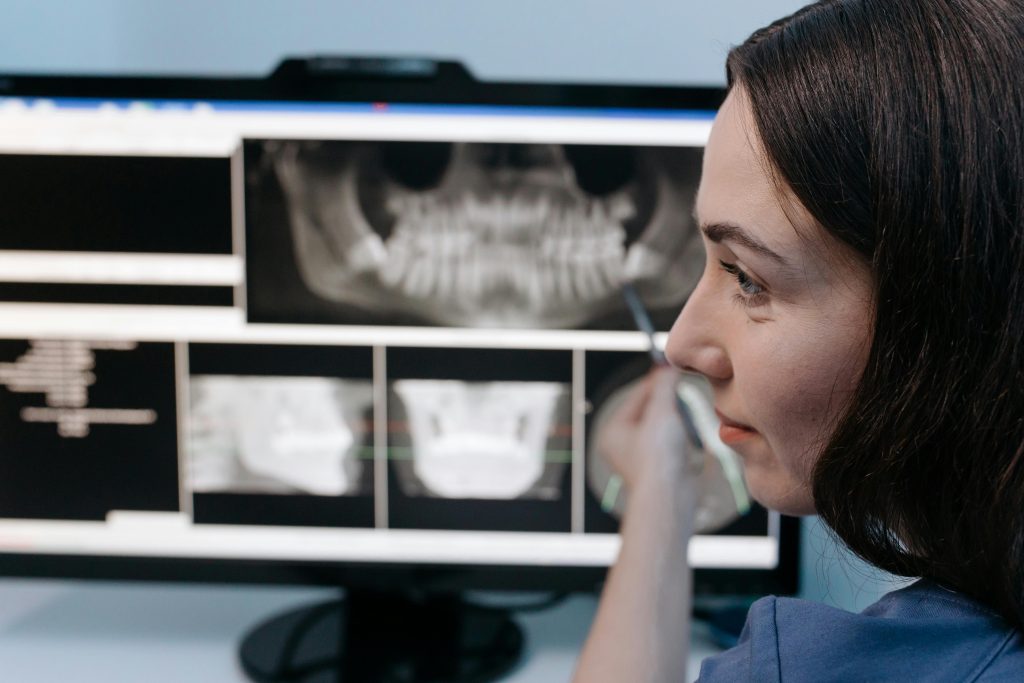We have all been there, asking that fearful question at the dentist: “Do I really need a crown right now? What can I do instead?” For decades, crowns have been the go-to solution in restoring a tooth, but we are here to tell you the good news. Science has advanced and provided dentists with a better and less invasive approach. The new approach? Biomimetic restorative dentistry, a new way of restoring your teeth that is much more natural, comfortable, and designed for long-term strength and resilience.
In short, biomimetic dentistry is about natural tooth restoration. Instead of aggressively removing existing tooth structure, this method utilizes what’s already there, employing advanced materials and professional bonding techniques to rebuild teeth from the inside out. Have we not piqued your interest yet? Not a problem, because this article will provide all the information you need as to why this new treatment is the way to go.
What Is Biomimetic Restorative Dentistry?
Biomimetic restorative dentistry is the most modern, natural-looking, and science-backed way of restoring your teeth. Believe it or not, it’s in the name! The word “biomimetic” derives from both bio, which means life, and mimesis, which means to imitate. There you have it, dental restorations that mimic the natural structure and behaviour of teeth.
Here are some key features of biomimetic dentistry:
- Tooth preservation: Only the decayed or weakened parts are removed.
- Advanced bonding: Strong bonding and layering techniques are used instead of cutting away large sections of your tooth.
- Natural performance: The restoration flexes and absorbs stress just like real enamel and dentin (beneath the enamel), reducing the risk of cracks or long-term failures.
As opposed to conventional dentistry, biomimetic techniques are not invasive but instead aim to extend the life of the natural tooth rather than replacing it.
What Are Dental Crowns?
If you don’t know already, dental crowns, which are custom-made by dentists, are “caps” placed over a tooth to restore its shape, size, strength, and appearance. Most often, they are typically provided when:
- A tooth has a very large cavity.
- There are cracks or fractures threatening tooth life and stability.
- After root canal therapy, when the tooth is weakened.
Yes, crowns are durable and at times reliable, but they usually require significant removal of existing healthy tooth structure so the crown can fit your tooth almost perfectly. One thing to note about crowns, they can leave your tooth vulnerable over a duration of time and may increase the chances of root canal treatment if the pulp (the soft, living tissue at the centre of the tooth) becomes irritated.

Biomimetic Restorative Dentistry vs Crowns: Key Differences
| Factor | Biomimetic Restorative Dentistry | Traditional Crowns |
| Tooth Preservation | Keeps your maximum tooth structure | Takes away both healthy and unhealthy parts of your tooth. |
| Invasiveness | Not aggressive, and is done with gentle drilling | Much more invasive, with large portions of your tooth removed |
| Durability | Stress-absorbent equal to the natural teeth’s strength | Strong but may fail over time |
| Aesthetics | Mimics the look of a natural tooth | Can look natural, but not perfect |
| Cost & Longevity | Fewer complications resulting in long–term savings. | Higher probability of complications leading to a higher cost total over your lifetime |
Benefits of Choosing Biomimetic Dentistry Over Crowns
- Preservation of Tooth Life
Because biomimetic dentistry substantially keeps most of your tooth intact, it reduces the trauma to your pulp. This provides a low chance of the need for future root canal treatments. - Stronger, Long-Lasting Restorations
By absorbing biting forces like a natural tooth, biomimetic restorations lower the risk of cracks, fractures, and more frequent dental work. - Natural-Looking Result
The advanced materials combined with highly skilled dental work make the biomimetic dentistry treatment blend near perfectly with your natural tooth, creating a restoration that looks and feels real. - Minimally Invasive = Less Discomfort
Less drilling means a more comfortable procedure, rapid healing, and reduced sensitivity post–treatment. - Future-Proof Dentistry
Each time your tooth is drilled and filled, it becomes increasingly vulnerable. The new and effective treatment is designed to break this routine by saving as much of the natural tooth as possible, protecting your oral health for years down the line.
When a Crown Might Still Be Necessary
In most cases, biomimetic restorative dentistry is the better alternative to a crown, but there are exceptions. Crowns will remain valuable in cases where:
- The tooth has been extremely damaged with little healthy structure left.
- There is a large decay that bonding agents alone cannot support.
- A tooth has suffered extreme cracks and fractures beyond the scope of restoration.
Where these situations are concerned, crowns will remain the stronger option. However, many cases typically treated with crowns could now be better managed with biomimetic methods.
How Natural Tooth Restoration Fits In
If there is anything that you should take away from this article, it’s that biomimetic dentistry is natural tooth restoration. Taking away the need to replace a tooth with an artificial shell, a specialized dentist carefully rebuilds it so it behaves like it did before the damage occurred.
This means:
- Maintaining tooth strength and resilience.
- Keeping your natural bite and regular chewing function.
- Achieving a flawless and likeness of natural-looking tooth.
For patients, it’s the best of both worlds: a tooth that looks natural and performs as it should, without the unnecessary drilling or structural loss.

FAQs About Biomimetic Dentistry vs Crowns
Is biomimetic restorative dentistry safer than crowns?
Yes. It really is much less invasive than crowns as it conserves more of your natural tooth and reduces risks of medium to long–term complications like root canals.
Does insurance cover biomimetic restorations?
It depends on your insurance provider. Many insurance plans categorize biomimetic treatments under standard restorative coverage, but details can vary.
How long do biomimetic restorations last compared to crowns?
With proper care and regular check-ins with your dentist, biomimetic restorations can last substantially longer than crowns, thanks to their stress-absorbing design.
Can every dentist perform biomimetic techniques?
Unfortunately, that is not the case. Biomimetic dentistry requires advanced training and mastery of specialized adhesive techniques. We recommend that you ensure your dentist has the skillset to provide the tooth restoration service.
Conclusion
Biomimetic restorative dentistry has transformed the way dentists repair teeth. By focusing on natural tooth restoration with very little invasiveness, it provides stronger, more natural, and long-lasting results compared to traditional crowns.
Indeed, crowns are still required for some severe cases; however, biomimetic dentistry often offers patients a healthier, more comfortable, and future-proof alternative.
It’s worth noting that, if you’ve been told you need a crown, ask your dentist whether biomimetic restorative dentistry could be a better choice for your smile!





